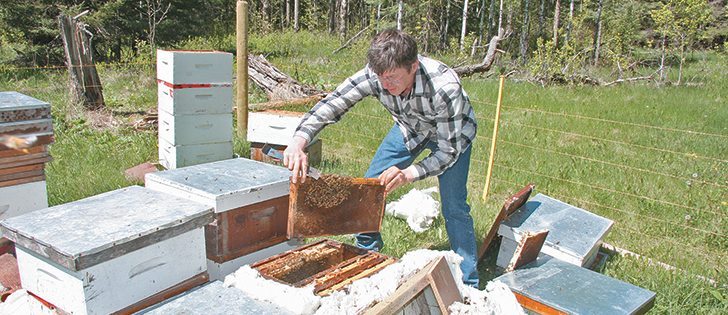Predators, weather A treatment for varroa mites proved fatal for some hives while a bear discovered others
TYNDALL, Man. — Beekeeper Jack Lee was first bitten by his hobby as a teen in northern Manitoba, where he encountered bees making their home in a hollowed out tree.
“It’s a fascinating animal to watch,” said Lee.
Decades later, he keeps his hives safe within the confines of an electric fence on his 80 acre wooded property south of Lake Winnipeg.
“He just loves bees,” said his wife, Deana Martz, who helps Lee with his hobby.
“Deliriously happy bees make delectable honey,” reads the business card for Wildwood Honey, which produces honey for farmers markets each year.
Read Also

Fuel rebate rule change will affect taxes and AgriStability
The federal government recently announced updates to the fuel rebates that farmers have been receiving since 2019-20.
Lee said his role is simply to encourage the bees to do what comes naturally.
“If they don’t like what you’re doing, they can leave,” said Lee.
He knows his bees well enough to sense when they are unhappy so most of the time he doesn’t suit up and this day is no exception.
Pointing to a screened hat and white gloves and coveralls near the hive boxes, he joked: “I look like I’m out for a fencing duel.”
They are wild beings with highly organized working colonies that are complex and hierarchical, he said.
The queen bee is a central figure among the bees in a hive, keeps order by secreting a calming pheromone and can reproduce 1,500 eggs daily.
At least 20,000 bees take care of her needs, bringing her food and taking out her trash, but she really has little freedom, said Lee.
“She’s not really the queen, but the slave,” he said.
Lee smiled as he described the dance bees do upon finding their favoured home sweet hive.
They weren’t so happy with a harsh organic treatment for varroa mites Lee tried last year. It killed half of his queens and led to high mortality rates in bees over the winter, leaving him with only two of six hives this year.
Hungry bears preying on unguarded hives, a late cold spring and lack of flowering plants made things go from bad to worse.
In the past, a 90 percent overwintering survival rate was the norm, he said. In winter, the hives are covered in light insulation and the entrances are partially blocked to protect the bees inside from the wind. The bottom boxes are filled with bees and the top box contains a pail of artificial nectar for the bees.
Soybeans and alfalfa are best for bees, which can travel a five kilo-metres radius in search of good food, he said. The less than ideal but plentiful canola in his region makes combs hard and honey more difficult to extract.
“They have an incredible sense of smell and are good at locating local flowers and communicating it to other bees,” said Lee.
Lee normally gets about 100 pounds of honey from each hive, with 200 pounds closer to the commercial average.
He sees increasing his hives to 100 in retirement, which could be within two years.
Martz cited the investment of thousands of dollars in equipment that includes an extractor for getting the honey out of the combs and an uncapper for taking the wax off of combs in addition to packaging.
“We’re kind of into it, we have to continue,” she said.
Lee said that each year is an education.
“If you quit now, you unlearn all you’ve learned,” he said.
- Bees do not hibernate in winter, but live actively throughout their four month confinement period and require large stores of honey and pollen to sustain themselves.
- When days start to lengthen the queen bee will start laying eggs and the hive will start to raise baby bees to replace those that died. In the spring, a hive that comes though strong will be split into three new ones.
- In every hive there are at least 20,000 bees and a single queen clustered together in a tight ball.
- Bees on the outside of the cluster point their back ends to the cold with their heads toward the centre. Huddling tightly, they interlock their hairy bodies giving the cluster a fur coat.
- By shivering their wing muscles, they can generate warmth. Each bee on the outside takes a shift and is replaced periodically with a bee from the centre.















